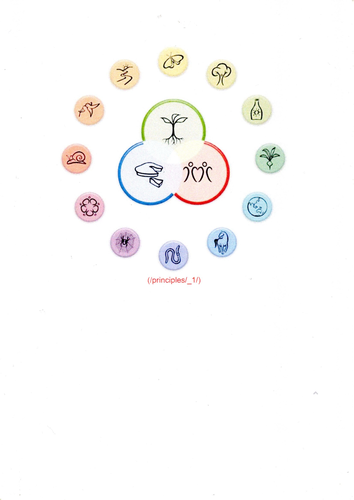




- Observe and interact
- Catch and store energy
- Obtain a yield
- Apply self regulation and accept feedback
- Use and value renewable resources and services
- Produce no waste
- Design from patterns to details
- Integrate rather than separate
- Use small and slow solutions
- Use and value diversity
- Use edges and value the marginal
- Creatively use and respond to change
Perrine and Charles Herve-Gruyer in 2003 bought a small farm in a village called Hellouin, in France. They were determined to start with goals of self-sufficiency and wanting to grow healthy organic food without the use of chemicals or machinery.
Few people had heard of organic farming. This they tried for 5 years but the yield did not make enough money to support the family.
An email in 2008 ,about Permaculture, from a friend, changed everything.
In the wild twice as much biomass , or plant material, grows naturally compared to farmland without the use of machinery or fossil fuels. It involves observing and learning from nature -how it makes new soil, protects and saves its water resources and how it adapts to climate.
Perrine went on a Permaculture course in the UK that winter.
They introduced vegetable beds which they did not dig but covered in mulch -plant cuttings and dead leaves. This protected the soil from drying out and made new soil as it rotted down. The result was more worms , fewer slugs and the vegetables grew better.
They planted different crops close together, fitting them four times closer then before.
They planted an edible forest with mushrooms, berries, fruit bushes and nut trees.
They dug ponds, with island gardens in the middle, so the water reached the plants through the ground- no more watering the crops with hoses or watering cans.
In their polytunnels they kept hens which eat the unwanted scraps slugs and snails, produced eggs and fertilized in the form of droppings.
The French National Institute of Agricultural Research began a scientific research.
After 10 years their 6,500 square farm had been transformed into an
enormous garden with crops (800 varieties of vegetables, fruit and herbs) , wild flowers, singing birds, ducks, frogs and insects.
The Herve-Gruyer family wanted to create something beautiful and the Earth gave back back to them in abundance. The farm, using the Permaculture ideals, produces 10 times more than a normal farm of a similar size.
Sources
Wikipedia
Earth Heroes Lily Dyu and Amy Blackwell
Something went wrong, please try again later.
This resource hasn't been reviewed yet
To ensure quality for our reviews, only customers who have downloaded this resource can review it
Report this resourceto let us know if it violates our terms and conditions.
Our customer service team will review your report and will be in touch.